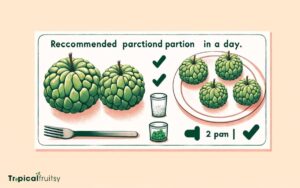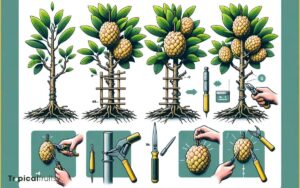How to Grow Custard Apple from Cuttings? 6 Easy Steps!
To grow custard apples (Annona squamosa) from cuttings, you must select healthy, disease-free branches, cut them into 6-8 inch segments, and treat them with rooting hormone.
Plant the cuttings in a well-drained potting mix, ensuring a humid and warm environment to encourage root development. With proper care, the cuttings will root and can eventually be transplanted to a permanent location.
Growing custard apple trees from cuttings is a practical method of propagation that can result in fruiting in less time than from seeds.
Here’s a step-by-step guide:
For example, a gardener would take cuttings during the dormant season, treat them with rooting hormone, and keep them in a greenhouse for the first few weeks to ensure the right conditions for rooting.
Custard apple cuttings require careful handling and optimum growing conditions
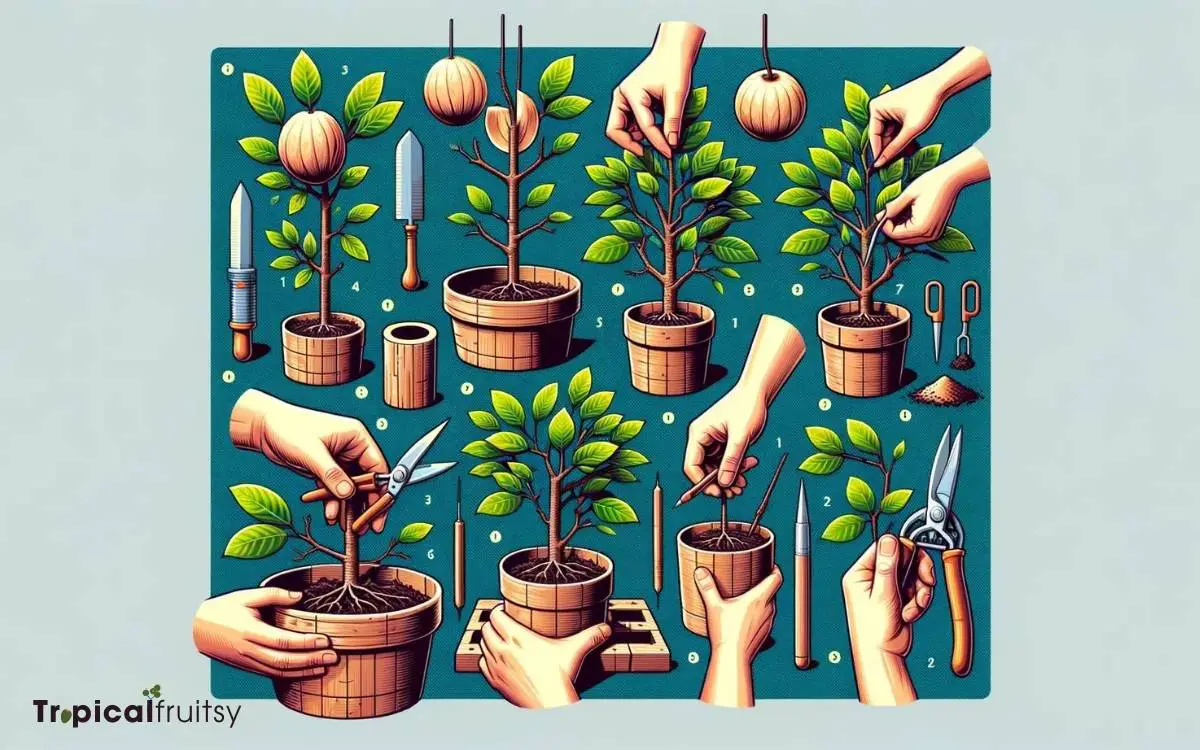
Key Takeaway
Step 1: Selecting Healthy Cuttings
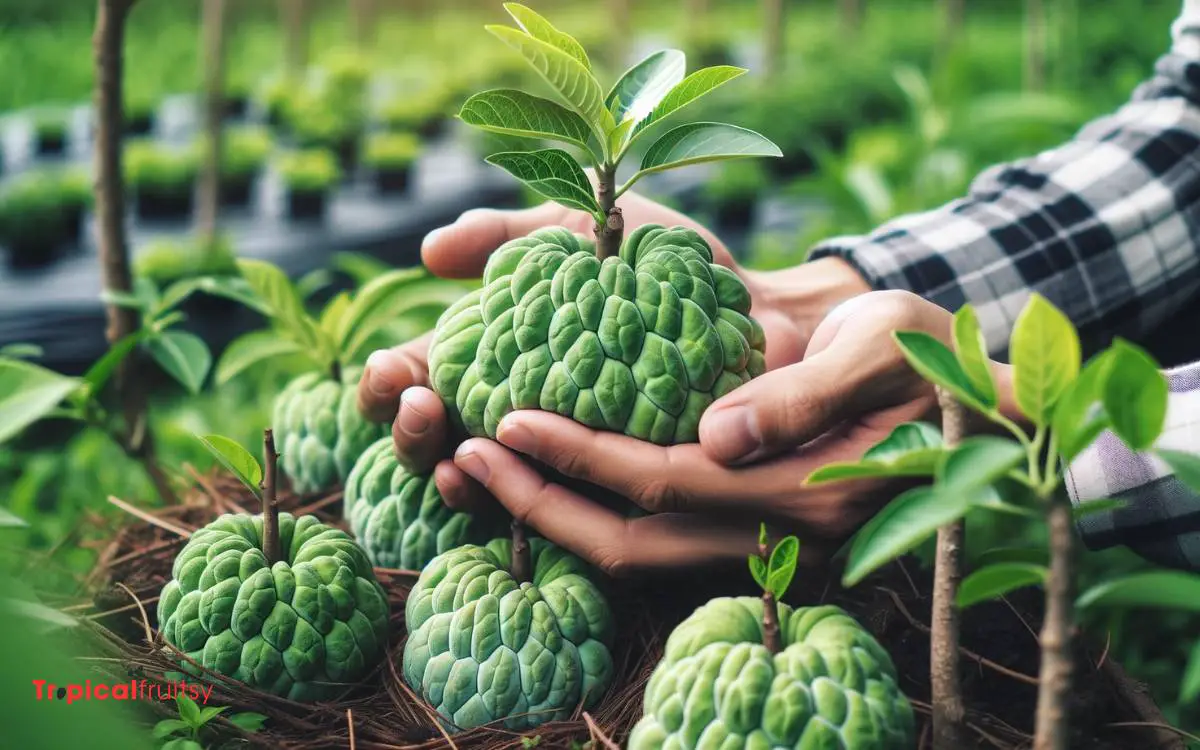
I’ll kick off the process of growing custard apples from cuttings by highlighting how to select robust and disease-free specimens.
It’s crucial to choose cuttings from a vigorous parent plant, ensuring they’re free from any signs of disease or insect damage.
The ideal cutting should be about 6 to 8 inches long with several nodes, as these are the points where new roots and shoots will emerge. A semi-hardwood stage, where the branch isn’t too tender nor too woody, is perfect for rooting.
The presence of mature leaves near the tip can indicate a healthy cutting, but you’ll want to remove most leaves to minimize water loss. Once you’ve selected the best cuttings, it’s time to prepare them for propagation.
Step 2: Preparing the Cuttings
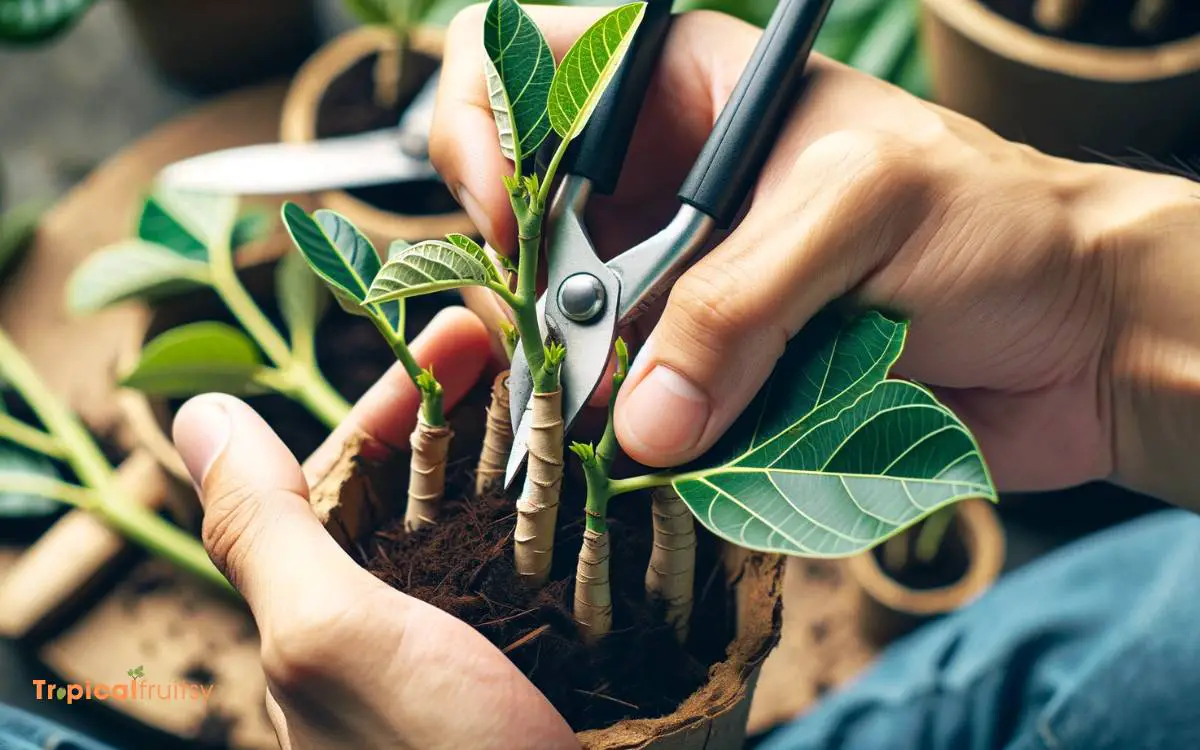
Having selected strong and healthy cuttings, I’m now ready to prepare them for rooting by trimming and treating them to encourage growth. The process is straightforward but requires attention to detail to maximize the chances of success.
Here’s a step-by-step guide:
| Step | Action |
|---|---|
| 1 | Cut the base at a 45-degree angle to increase the surface area for rooting. |
| 2 | Remove leaves from the lower third to prevent rotting. |
| 3 | Dip the cut end into a rooting hormone to stimulate growth. |
| 4 | Make a small 2cm vertical cut at the base to further encourage root development. |
| 5 | Let the cutting air dry for a few hours to form a callus over the cuts. |
Each step is crucial for successful rooting. Don’t rush; take your time to do it right.
Step 3: Rooting Hormone Application
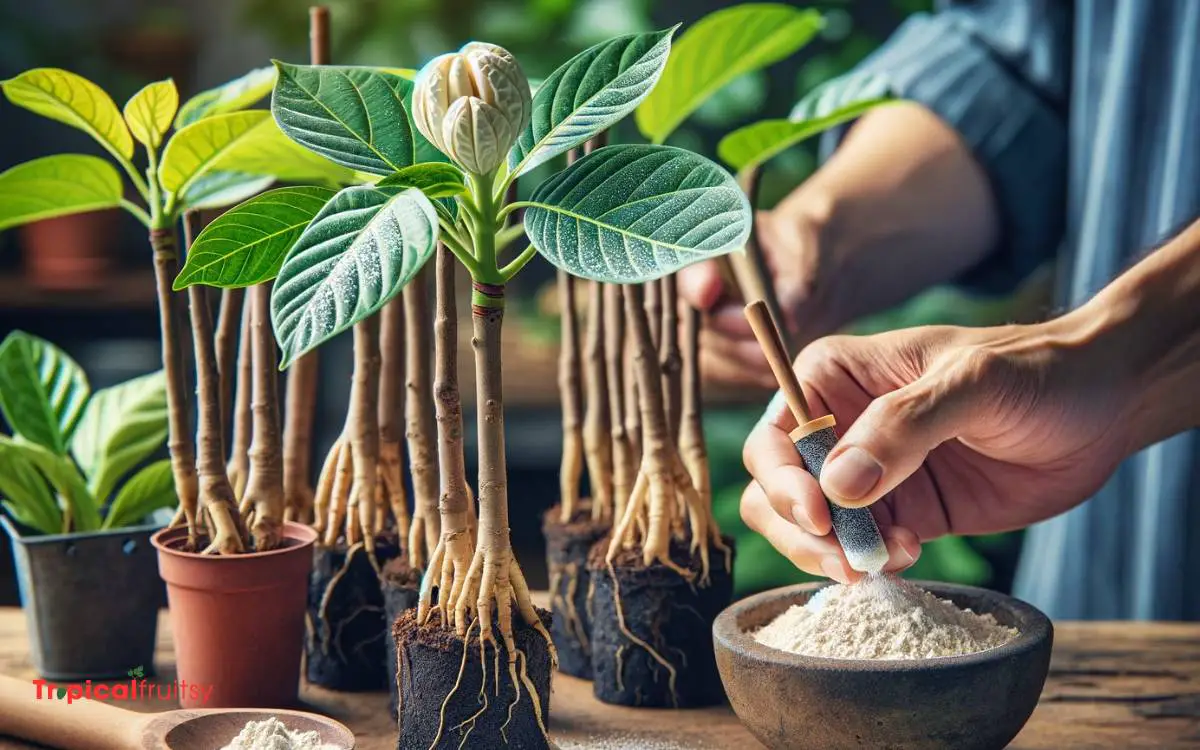
Rooting hormone is my next critical step, ensuring the custard apple cuttings develop strong roots quickly.
This substance mimics the natural plant hormones that stimulate root growth, providing a boost that can significantly increase the chances of successful propagation.
Here’s how I apply it effectively:
- Dip the Base: I gently dip the base of each cutting into the rooting hormone powder, ensuring a thin, even coating. Too much can harm the cutting, so I tap off the excess.
- Avoid Contamination: I never dip directly into the original container; instead, I pour a small amount into a separate dish to prevent contamination.
- Immediate Planting: After application, I promptly plant the cuttings into the prepared growing medium to avoid hormone degradation and maximize effectiveness.
Step 4: Choosing the Right Soil
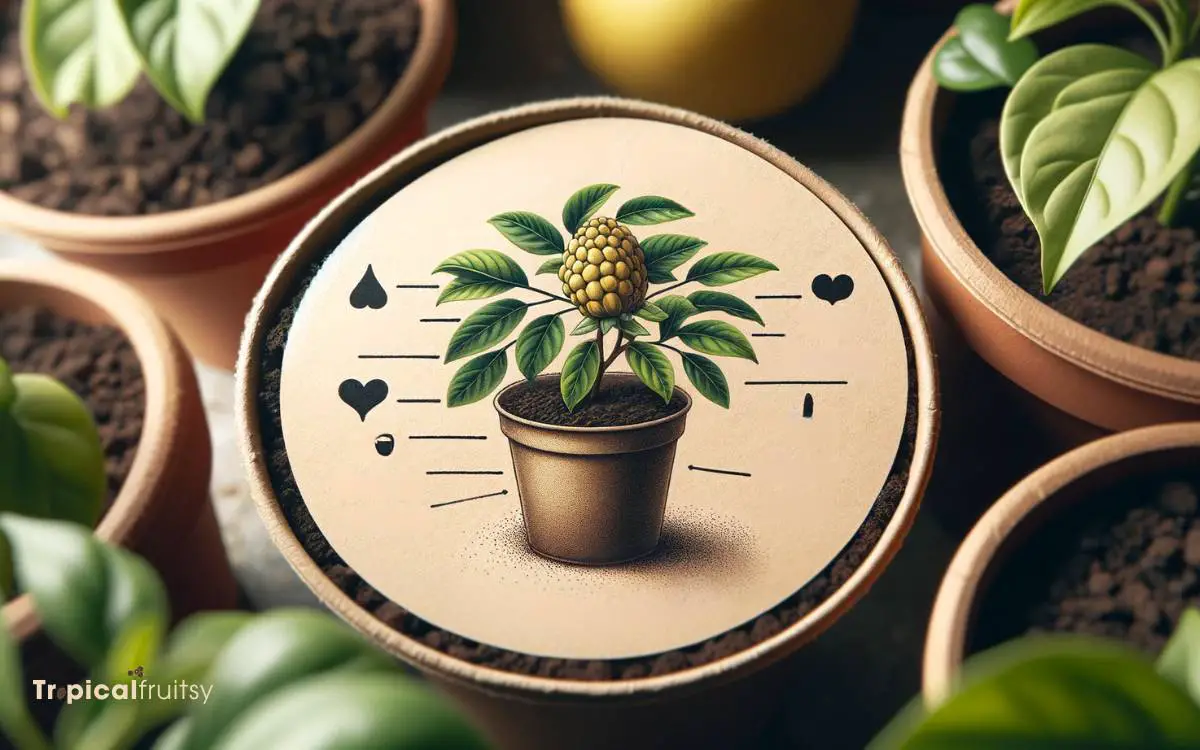
Selecting the ideal soil for your custard apple cuttings is crucial for successful rooting and growth. It’s essential that the soil’s pH level is slightly acidic to neutral, as this optimizes nutrient uptake.
Ensure the soil offers excellent drainage to prevent root rot, while also being rich in organic matter to nourish the developing plants.
Soil Ph Levels
Why should I pay attention to the soil pH levels when choosing the right soil for growing custard apple from cuttings?
Well, the pH level of the soil has a profound impact on the health and growth of the plant.
Here’s precisely what you need to know:
- Optimal Range: Custard apple plants thrive in slightly acidic to neutral soil, with an optimal pH range of 6.5 to 7.5.
- Nutrient Uptake: Soil pH affects the availability of essential nutrients. If the pH is off, custard apple cuttings may struggle to absorb what they need to grow.
- Microbial Activity: The right pH fosters beneficial microbial activity in the soil, which in turn supports plant health and root development.
Choosing soil with the correct pH level is crucial for giving your custard apple cuttings the best start.
Drainage Properties
I’ve found that well-draining soil is essential for the successful propagation of custard apple cuttings, as it prevents root rot and fosters strong root growth.
Choosing the right soil mix can make all the difference. Aim for a blend that’s loose and aerated, such as a mix of loam, peat, and sand.
This combination ensures excess water drains away quickly while retaining adequate moisture and nutrients. I usually go for a ratio of 40% loam to 30% peat and 30% sand, which has never failed me.
It’s important to avoid heavy, clay-based soils as they can hold water for too long and suffocate the delicate roots. Remember, a healthy root system is the cornerstone of a thriving custard apple plant.
Organic Matter Content
While choosing the right soil for your custard apple cuttings, it’s critical to consider the organic matter content, as it provides essential nutrients and improves soil structure.
Organic matter plays a pivotal role in fostering healthy root development, water retention, and providing a habitat for beneficial microorganisms.
Here’s what you should look for in the soil:
- Richness in Compost: Ensure the soil contains well-aged compost to supply a balanced mix of nutrients.
- Presence of Worm Castings: Adding worm castings can enhance the fertility and structure of the soil.
- Quality of Peat Moss: Incorporating peat moss helps in retaining moisture and provides an acidic pH balance, beneficial for custard apple cuttings.
Opt for a soil blend that’s loamy and fertile, with these organic components to give your cuttings the best start.
Step 5: Planting the Cuttings
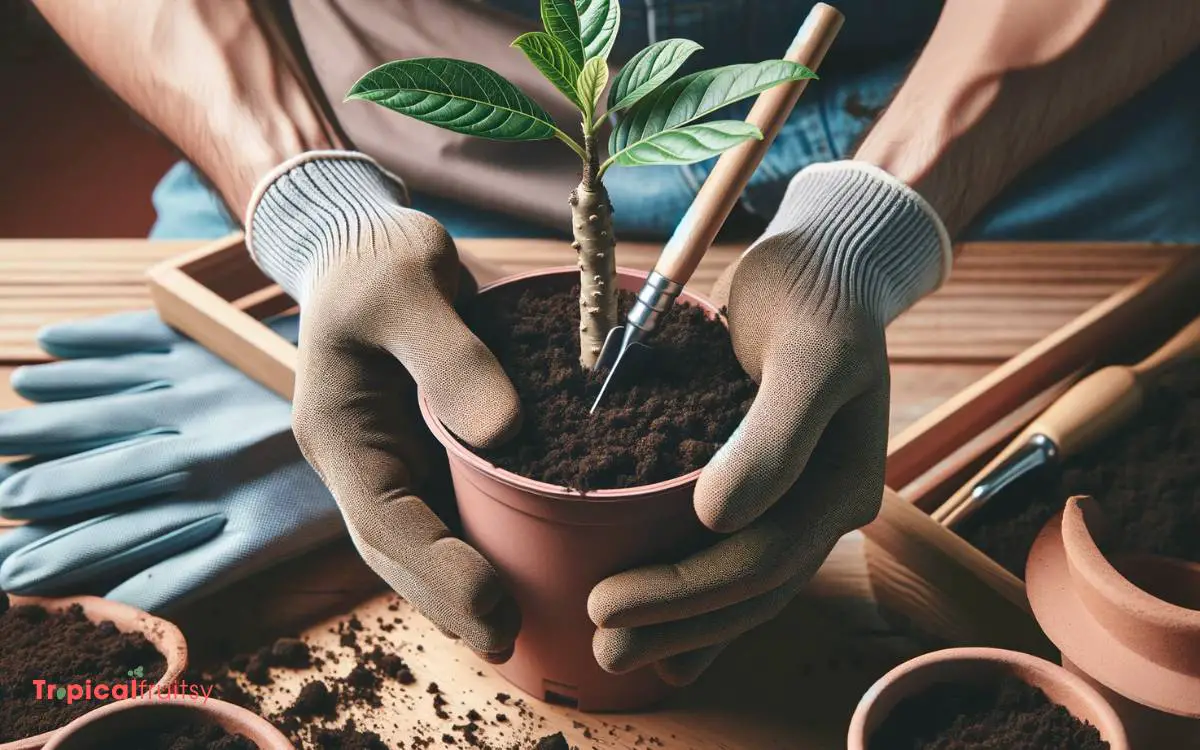
Now that we’ve prepped the ideal soil, it’s crucial to focus on how to plant custard apple cuttings properly.
I’ll guide you through selecting healthy cuttings, ensuring they’re planted at the correct depth, and establishing the right moisture levels to encourage rooting.
Cutting Selection
Why should I choose healthy, mature stems for my custard apple cuttings to ensure successful planting? It’s crucial because these stems have the highest potential to root and grow into robust plants.
Here’s what I look for:
- Vibrant Color and Texture: I select stems that have a green, firm texture, indicating good health and vigor.
- Maturity: I opt for stems that are neither too young nor too old, typically around one-year-old, as they root more effectively.
- Node Presence: I ensure each cutting has multiple nodes, the points where leaves attach to the stem, since roots often emerge from these areas.
Soil Preparation
Having selected the ideal cuttings, I’ll now focus on preparing a well-draining soil mix to ensure the best possible start for my custard apple plants.
The key here is to create an environment that mimics their native soil conditions, which are typically loose and fertile.
I’ll mix one part sand with two parts garden soil, and then add some organic compost for fertility. This combination promotes good drainage while still retaining adequate moisture and nutrients.
I’ll also ensure the soil is slightly acidic to neutral, aiming for a pH between 6.5 and 7.5, which is ideal for custard apples.
Before planting the cuttings, I’ll water the mix thoroughly, letting any excess drain away. This step guarantees the cuttings aren’t going into dry soil, which can hinder their initial growth.
Moisture Management
I’ll carefully monitor the moisture levels after planting the cuttings to ensure they’re consistently damp, but not waterlogged, which is crucial for encouraging root development.
Achieving the right balance is key, and here’s how I do it:
- Water Wisely: I water the base of the cuttings thoroughly at planting, then switch to misting the surface lightly every day or two to maintain moisture without causing saturation.
- Check Soil Regularly: I stick my finger an inch into the soil daily; it should feel moist but not soggy. Adjust watering accordingly.
- Use Mulch: I apply a thin layer of organic mulch around the cuttings to help retain moisture, reduce evaporation, and provide a stable environment for the new roots to grow.
Are the Steps for Planting Custard Apple Seeds Similar to Growing from Cuttings?
Yes, the steps for planting custard apple seeds are similar to growing from cuttings. Both methods require preparing the soil, planting the seeds or cuttings, and providing proper moisture and sunlight. However, with seeds, there is an additional step of germination before the plant can start growing.
Step 6: Providing Optimal Care
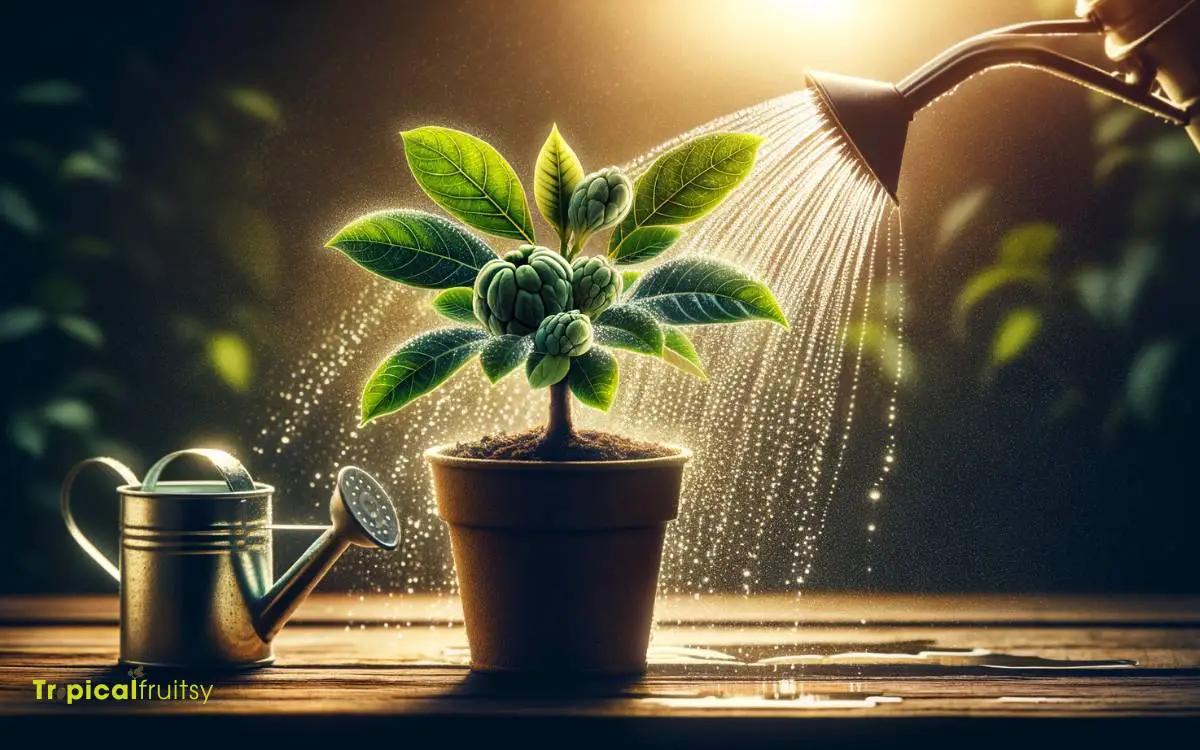
Once your custard apple cuttings have rooted, it’s crucial to give them the right amount of water, light, and nutrients to thrive. I ensure they’re watered deeply but allow the soil to dry slightly between sessions to prevent root rot.
I’ve found that custard apple plants love bright, indirect sunlight, so I place them where they’ll receive this exposure without getting scorched by the midday sun.
I also feed them a balanced, slow-release fertilizer every few months to support their growth. It’s important not to overfeed, as this can cause more harm than good.
Monitoring for pests and diseases is part of my routine care, as early detection is key to keeping my plants healthy.
Troubleshooting Common Issues
Despite careful attention, I’ve encountered several common issues when growing custard apple from cuttings, such as leaf yellowing and root rot.
Here’s how I’ve learned to tackle these problems effectively:
- Leaf Yellowing: Usually, this indicates a nutrient deficiency or poor drainage. I ensure my soil has a balanced mix of nutrients and check that the pot has adequate drainage holes.
- Root Rot: This often happens due to overwatering. I’ve adjusted my watering routine to make sure the soil is moist but not waterlogged, and I’ve increased the pot’s drainage.
- Pest Infestations: Aphids and mealybugs can be a nuisance. I regularly inspect the cuttings and apply neem oil or insecticidal soap to keep these pests at bay.
Conclusion
I’ve found that with a bit of patience and the right techniques, growing custard apples from cuttings can be rewarding.
Interestingly, nearly 80% of all custard apple trees cultivated worldwide start from cuttings or grafts, showcasing their high success rate. Remember to select healthy cuttings, use rooting hormone, and provide tender care.
As you troubleshoot any issues, keep in mind that each step is crucial to your sapling’s growth.
Here’s to your fruitful endeavors!


